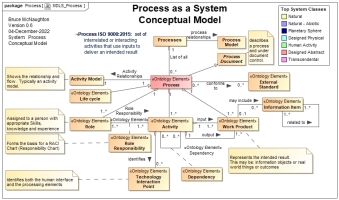System: Process
Name: Process
Based on: Designed Abstract System
A process![]() set of interrelated or interacting activities that use inputs to deliver an intended result. ISO 9000:2015. is a set of interrelated or interacting activities that use inputs to deliver an intended result. ISO 9000:2015.
set of interrelated or interacting activities that use inputs to deliver an intended result. ISO 9000:2015. is a set of interrelated or interacting activities that use inputs to deliver an intended result. ISO 9000:2015.
Activities:descriptions of two or more activities to be carried out by people in the organisation. The activities also identify the Technology Interaction Points.
Inputs: The work products to be used or conditions necessary to carry out the activity
Interrelated or interacting: The activities within the process work together to produce the intended results required to achieve the objectives and goals of the process.
Intended Result: The intended result can be an output of a process, a product or service from the organisation. Other terms used are work product, outcome, etc.
A process is a necessary element for the realization of a capability within an organization.
Process is also called:
-
Business Process
-
Team Process
-
Organizational Process.
Each process has a specific purpose and set of results or outcomes. A process is described in a process description.
The purpose of the Process as a system is:
-
To identify the key activities to be performed by people to support a named Capability
-
To create a process description in a consistent way to make it easy for people to use.
-
To provide consistent guidance and information to support the Process
-
To ensure that technology is aligned to the Process
-
To ensure that training and examples are derivable from the process.
The following are key principles about process descriptions
- Activities, Decisions and Relationships are the core elements of business processes
- A person assigned to a role carries out activities (activity descriptions) that use and produce information or deliver an output / outcome.
- Critical activities are those that contribute to the achievement of objectives necessary to deliver the organisation's purpose.
- Processes are designed based upon knowing the skills, knowledge and experience of a person carrying out an activity.
- Processes must be owned and managed throughout the life cycle of a capability to deliver the required performance.
- Each process must have a capability owner responsible for managing the process development, implementation, improvement and performance
- Capability Managers are responsible for the development, implementation and improvement of the process.
- Capability Managers are responsible for the business case for the investment for use and improvement
- Activities within processes identify the Technology Interaction Point necessary for proper integration of technology into the work.
- Inputs and outputs of a process are work products. Work products may be documents, people, or assets.
System Quantity Properties
-
Number of Roles Defined or shared
-
Number of Activities in the Process
-
Number of completion criteria
- Number of improvements
Systemic Quality Properties
- Ease of use
- Consistency of outcome
- Planning accuracy
Systemic Capabilities or Functions
- Each process provides unique functions and capabilities when used in a capability.
- These functions are described in the process outcomes.
- functions for measurement and reporting (performance evaluation and status)
- Functions for information management.(records management / configuration management)
System States
The various defined states that the capability as a system-of-interest can be in.
- Identified (as in an architecture)
- Planned (a team has been established)
- Designed.
- Developed.
- Piloted
- Rolled-out where used
- Maintained
- Improved
- Retired
Capability Development Stakeholders in a Capability Innovation Team developing a capability and the core process.
Organizations using a Capability
-
People (Practitioners) that are part of the capability
-
Managers who plan and realize the capability in their organization or team.
The Capability that incorporates the process forms the environment of the process.
See the Capability
System Element: Identification and Relationships
The process documentation is made from using the Capability Innovation Life Cycle.
The following work product descriptions provide more details:
Process Documentation (including Process Design Patterns)
Provides an overview of all process documentation
Configuration / Scenario:
Describes any configuration / scenario attributes for a specific system-of-interest. This may not be appropriate for all system descriptions (e.g. patterns or abstract systems).
Cyclical (Repeating / Regular) Processes
The activities identified in the process form the regular and repeating processes when the process is used.
These are triggered by the events identified for each activity
Trigger: Entry point for an activity: Process: Actions to carry out the activity for the person with an identified role.
Changes are identified for a process based upon use. The normal Change Process is used.
Trigger: Issue / improvement based upon use Process: Record the issue / improvement in the capability improvement log.
Development Life Cycle Processes
Development activities take the process through the life cycle of Capability Innovation Life Cycle. Any improvements are coordinated by a Capability Innovation Team. The capability innovation team uses the capability models, capability set models, and strategic plans to determine the changes to the life cycle of a process. (See Capability).
The following references support this type of system-of-interest.
